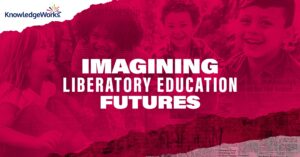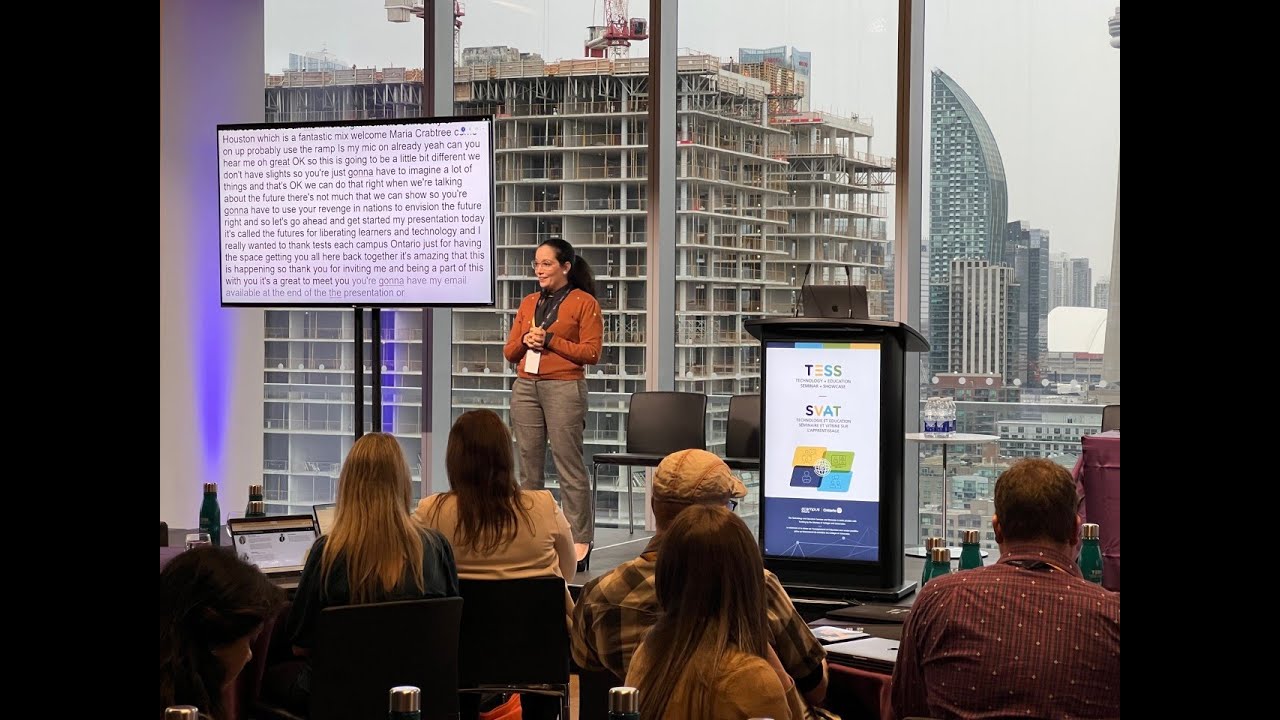Last fall I was invited to be the keynote speaker at eCampus Ontario’s Technology and Education Seminar and Showcase (TESS) Conference. As I started to ponder about what I wanted to communicate to this audience, I found myself telling the story about why and how we created Imagining Liberatory Education Futures and how it related to educational technology.
Back in 2020 when we began ideating our research process for our next forecast, we started to look around at the state of things in that moment in time. Technology, specifically in education, was a major issue then and will be in education futures. So we started to wonder: Whose future is being narrated, reproduced, sold, consumed, advertised, planned for and prioritized? Whose future have we been telling in all our years exploring future possibilities for education?

Explore four possible futures in which liberatory education exists within those settings in our sixth anchor forecast Imagining Liberatory Education Futures. Read now »
As a response, we decided to open our research process to other contributors beyond our strategic foresight team – and beyond KnowledgeWorks – to ensure the process was inclusive and equitable. With the research question guiding us, “To what extent could public education be unconstrained by systems and structures of oppression in 20 years?” we created the forecast, centering four future stories of liberatory education. In these stores, we identified the following technology advancements influencing those futures:
- The West Valley Rural Education And Liberation Commons Youth Hive designed a collaborative online forum to inform people about, and mobilize action on, issues shaping their futures, such as climate change and social justice.
- LiberateNet, an unindexed safe space on the web, is a vibrant online home for emancipatory micro-learning structures and the learners, parents and community members who seek them out.
- The Inner Soul Project in 2029 launched Virtual Ancestor, an artificially intelligent elder that provides youth access to ancestral perspectives, elder wisdom and support.
And there are many more mentions of technology throughout the forecast. Some more familiar, others more provocative, all insightful:
- Labor automation
- Non-commercial social media
- Open education resource platforms
- Digital ledgers for credentials
- Smart contracts
- Recommendation engines
- Augmented reality
- Virtual-reality lessons
- Job-matching apps
- Data dashboards
- Universal high-speed broadband internet
- Hybrid, constituent-driven town halls
- Public-service automated interfaces
- Auto-scoring software
- Digital, self-paced lessons
- Adaptive learning software
- Data agreements among schools, employers and economic development agencies
After revisiting this information, I took some time to analyze it with fresh eyes and I noticed how these technologies illustrate two types of change and two types of futures. Simply adding technologies to education systems does not change them in any fundamental way. It makes them more efficient at perpetuating inequities. Learn more »
Types of change
- External change: change that originates in other domains outside of education but that could have a big impact in education, such as labor automation or job matching apps
- Internal change: change that originates in education and could have a big impact in other domains outside of education, such as auto-scoring software or adaptive learning software
Types of futures
- Tech-based: futures driven by the advancement of innovative and cutting-edge technology like digital ledgers or virtual-reality
- Value-based: futures driven by the values supporting already familiar or existing technologies that as result would underpinned different ways of using it like non-commercial social media or universal high-speed broadband internet
Ultimately, this fresh look at the role of technology in creating liberatory education futures for each of us led me to a confirmation followed by a new realization. It confirmed for me one of the eight insights and implications from our forecast, that yes, technologies can be channeled for liberating learners. However, this also means that technology can do the complete opposite. It is our responsibility as education stakeholders to ensure that education technologies are designed and deployed to liberate learners.
Engage with technology’s impact on education with our board game, design to spark conversations for those at the table on the education future you all want. Order a copy today »
Below are some things to keep in mind as you are making decisions today about the technologies that we introduced in our education systems:
- The future needs to start sometime: Yes, you could probably wait until Monday or the next planning cycle… but why not now? There must be something to get you started, even finishing reading this blogpost and continuing with our forecast counts.
- Technology will continue to shape our behaviors and vice versa: Let’s use this knowledge to our advantage and attempt to reverse-engineer technologies that cultivate the behaviors and mindsets to help those around us thrive rather than perpetuate the status quo.
- Education stakeholders should monitor external and internal change: Because education does not exist in a bubble and its deep connections to other social systems are not going to go away.
- Begin with the future in mind: When creating new tech programs or solutions start by exploring potential ways in which it could interact with other people or part of the system in the future and then come back to the present to incorporate those insights by design instead of scrambling for superficial band-aid fixes along the way.
- Anticipate short- and long-term consequences and knock-on effects: For better or for worse some things take time to show their true colors. By having a better idea about what to expect at varied timeframes we can know what to look for when, measure, assess and, if necessary, correct. Also remember to explore the different chain reactions that could be set off by one change, even it feels distant and unrelated.
- Technology is a vessel into which we pour our values: Let’s consciously fill the vessels that we have control over with the values that will support our ideal future. Accountability and consistency could go a long way with this one.
Bonus tip! As we all consume, explore, imagine, dream and engage with stories of the future, particularly tech-heavy ones, it is important to remember that you have always the power to ask yourself, “Whose future is this?” “Why is it important that I know about it?” and, “What values are underpinning this future?” This critical lens will be your key to unlocking futures for liberating learners.
Watch the keynote below for more.







